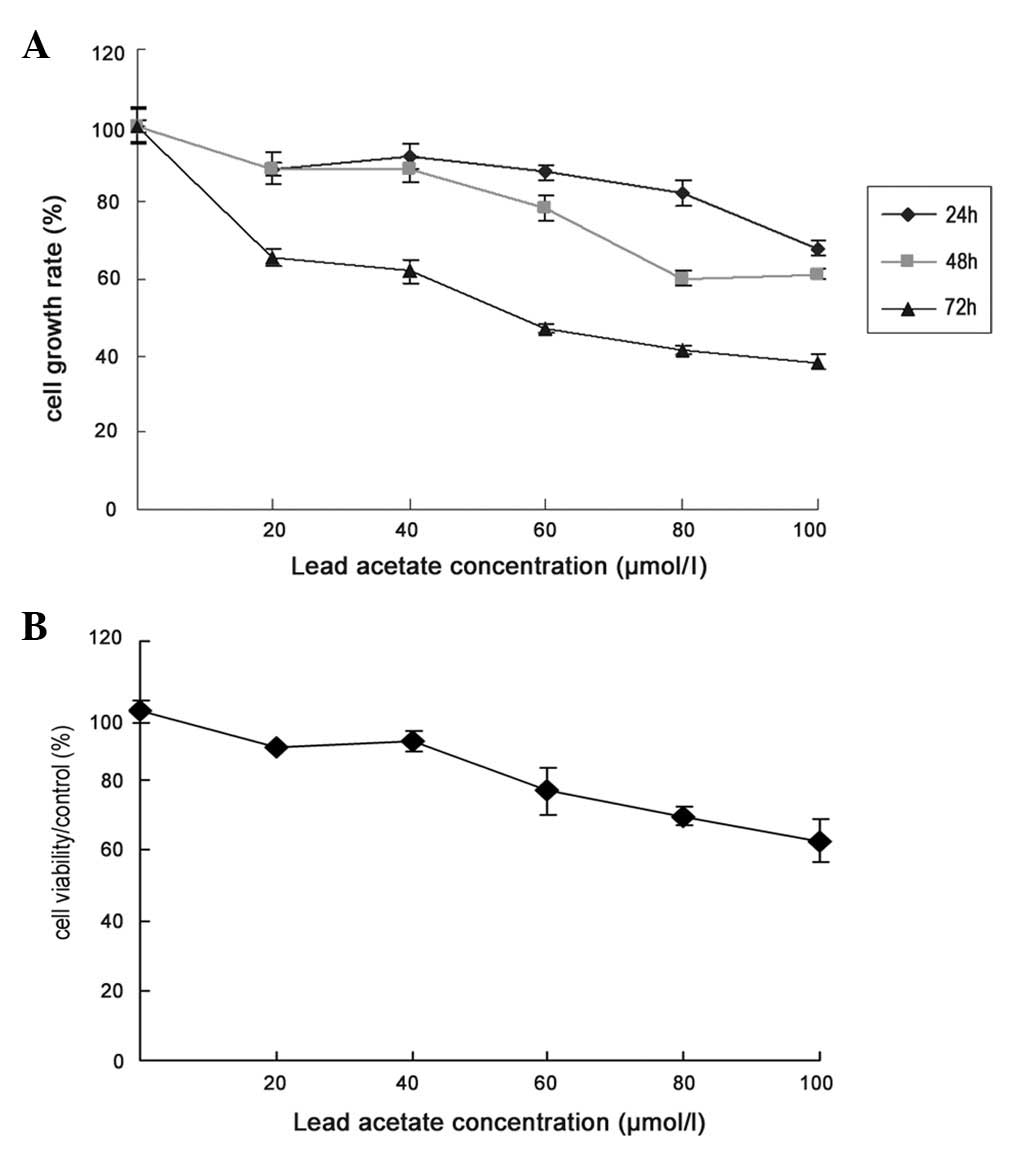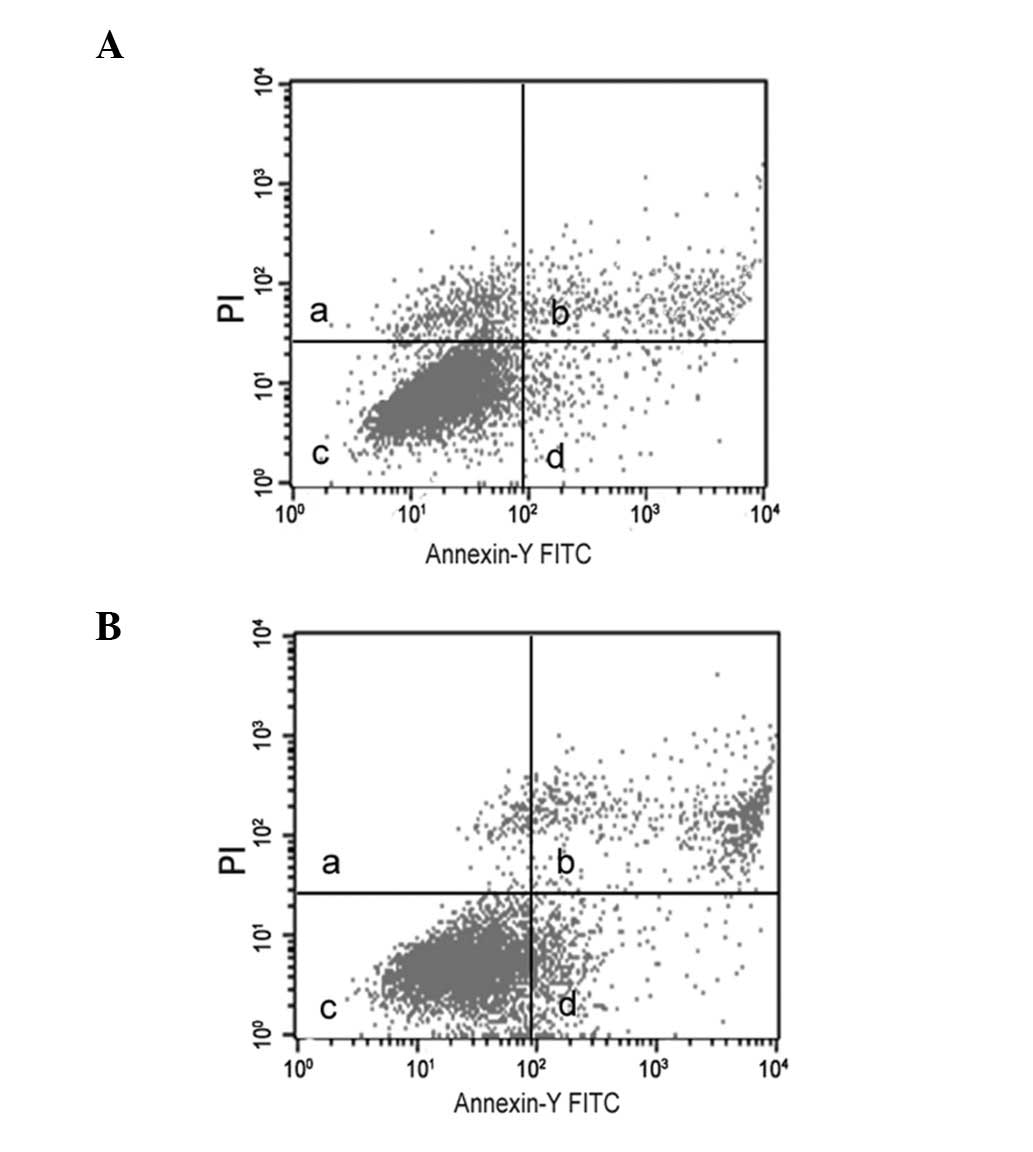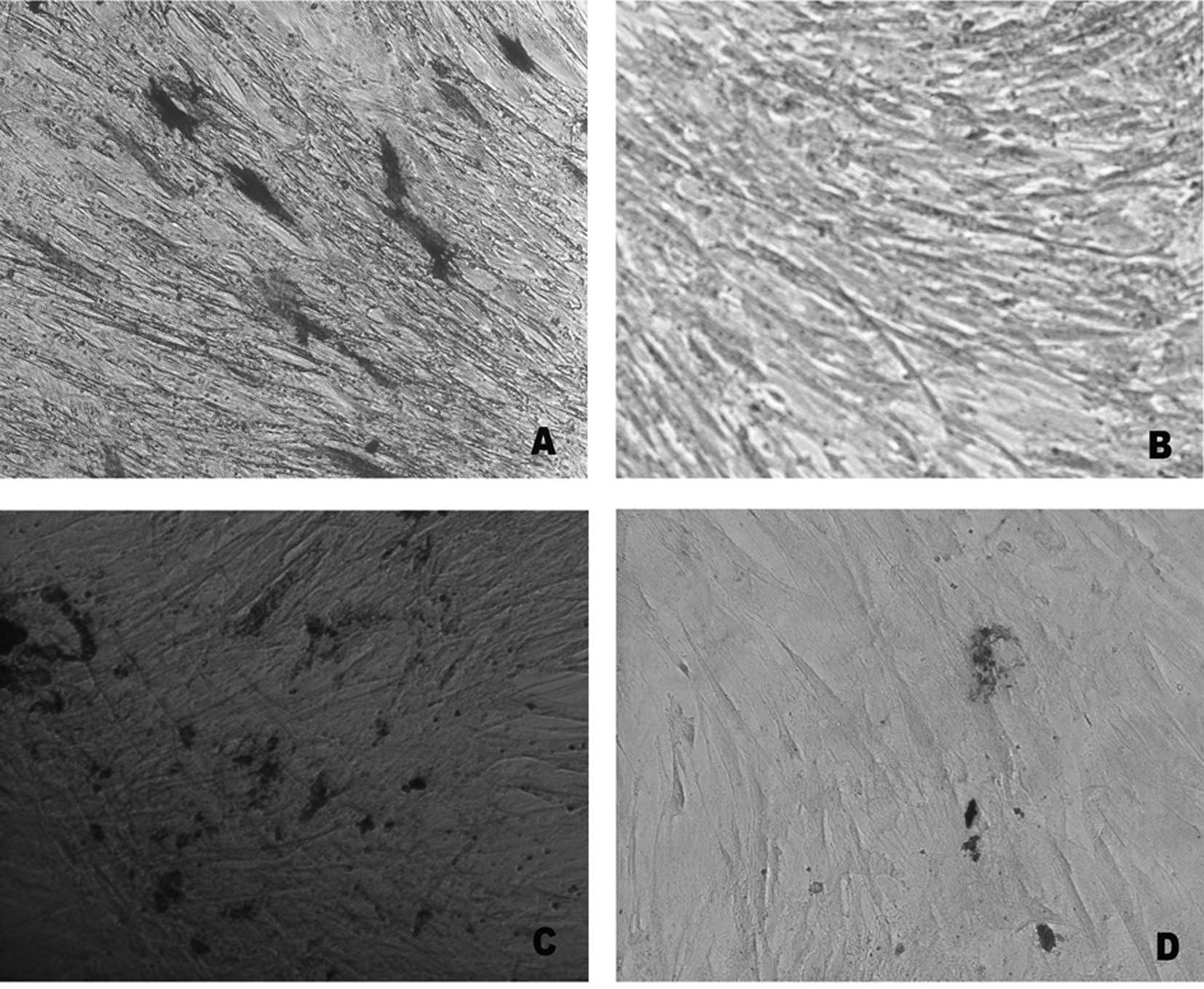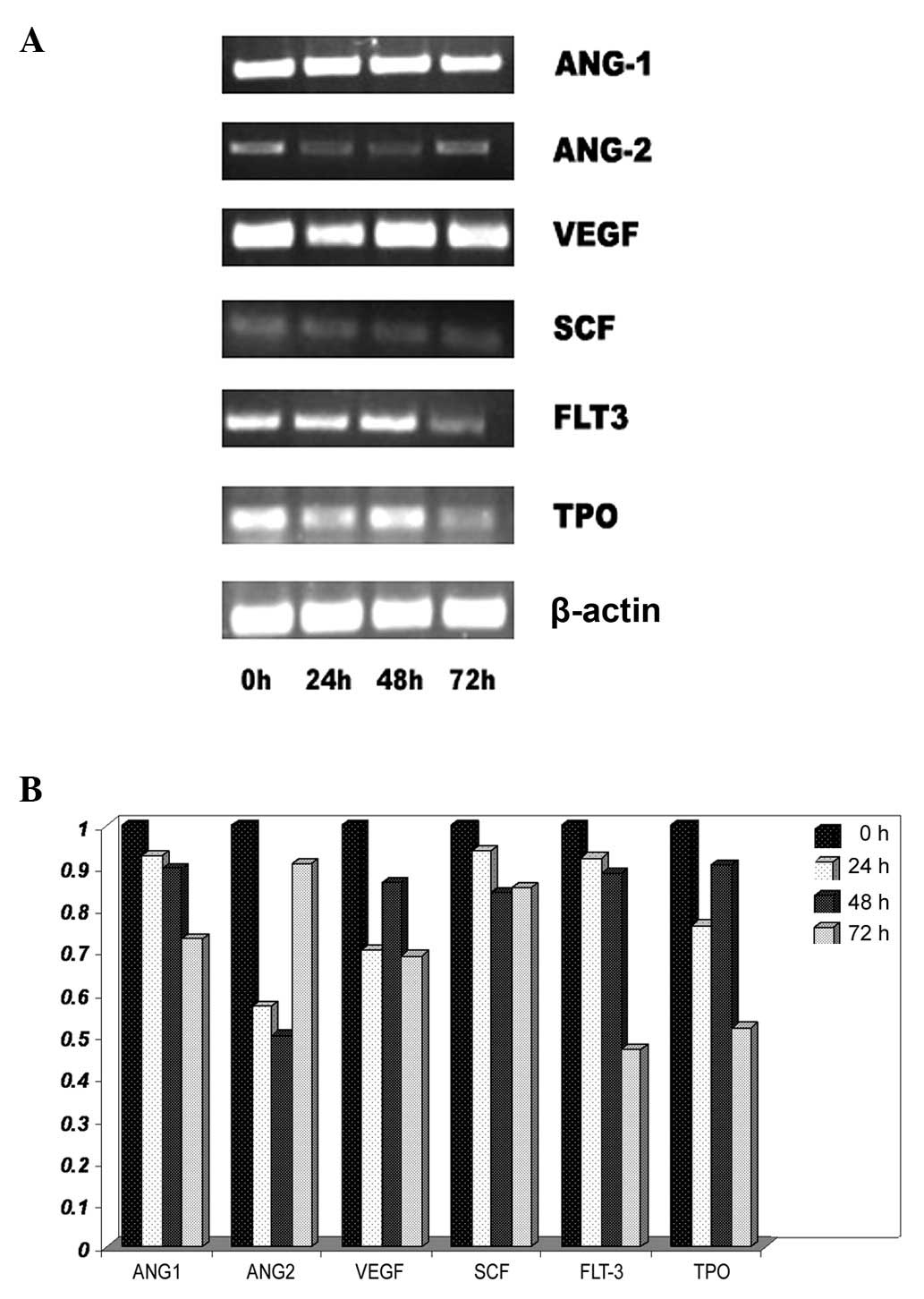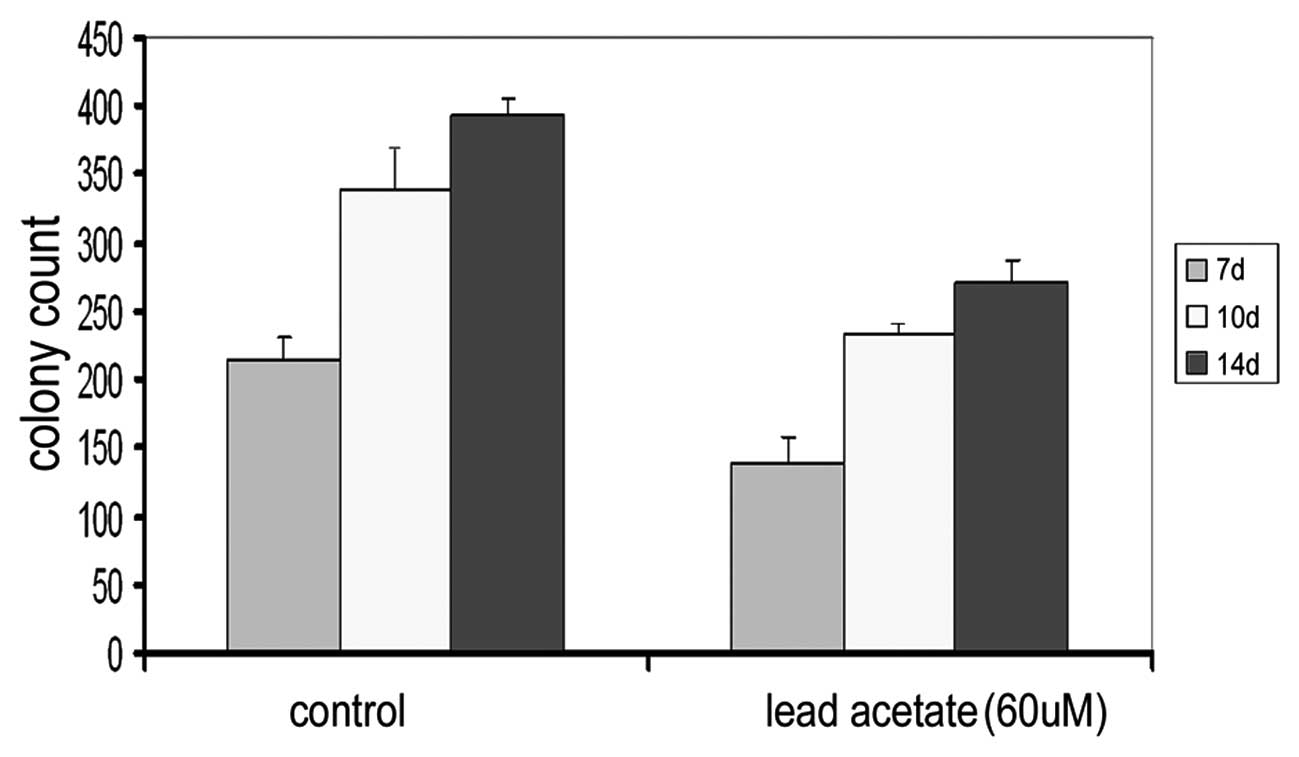Lead acetate reduces the ability of human umbilical cord mesenchymal stem cells to support hematopoiesis in vitro
- Authors:
- Published online on: July 31, 2012 https://doi.org/10.3892/mmr.2012.1014
- Pages: 827-832
Abstract
Introduction
Plumbum (Pb), one of the most widespread pollutants in the world, induces oxidative stress and dysfunction in many cell types (1). For humans, the major sources of exposure to lead compounds include air, dust, food, water and batteries (2–5). Lead has been found to cause neurotoxicity, reproductive toxicity, liver toxicity, kidney damage, hematological dysfunctions and immunotoxicity (3). Among all of these, the hematological system has been proposed as an important target for lead-induced toxicity. Approximately 99% of the lead present in the blood is bound to erythrocytes. Moreover, erythrocytes may spread lead to different organs of the body. The effect of lead on health depends not only on its total dose and the length of exposure but also on the physical and chemical state of the element and the physiological status and age of the individual (6,7). The most vulnerable groups at risk of harm from lead exposure are fetuses and children of preschool age (6,8). A previous report demonstrated that iron deficiency was associated with higher blood lead levels in children (9).
In the current study, we used inorganic lead and lead acetate to investigate the effects of lead on the proliferation, osteogenic differentiation and hematopoiesis-supportive function of mesenchymal stem cells (MSCs). Stem cells may provide a model of cells undergoing differentiation and proliferation for toxicology assays (10). For example, embryonic stem cells have already provided new assays to predict embryo-fetal developmental toxicity in vitro(11). However, certain problems are encountered with the application of embryonic stem cells, including complicated culture methods, high costs and ethical concerns. MSCs, a type of adult stem cell, are capable of self-renewal, have multipotent differentiation potential (12,13), may be isolated from different tissue sources, and are easily isolated from bone marrow (BM) and expanded in vitro(14–17). They are capable of supporting hematopoiesis (18), enhancing angiogenesis (19) and repairing tissue (20). Thus, it is clear that any cellular stress in MSCs is capable of markedly diminishing the hematopoietic system. The hematopoietic system is vulnerable to environmental toxins and heavy metals such as cadmium (21) and lead (22). They interfere in the hematopoietic system through the damage of genetic material of stromal and hematopoietic cells and the alteration of cytokine homeostasis. It is, therefore, necessary to explore the lead-induced response of MSCs.
Materials and methods
Cell culture
Human umbilical cord mesenchymal stem cells (UCMSCs) were isolated from umbilical cord Wharton’s jelly. Umbilical cords were obtained from the Fourth Hospital of Zhenjiang, China. Umbilical cords were rinsed twice by phosphate-buffered saline (PBS) in penicillin and streptomycin. The tissues were minced into 1–2 mm3 fragments. They were cultured in a 37°C incubator in plates with low-glucose Dulbecco’s modified Eagle’s medium (L-DMEM) (Gibco, USA) supplemented with 10% fetal bovine serum (FBS), 100 U/ml penicillin and 100 U/ml streptomycin. The medium was changed every 3 days. After approximately two weeks, there were cells at the edge of the tissue fragments. When UCMSCs grew to 70% confluence, they were detached by 0.25% Trypsin-EDTA and reseeded in a flask of 5,000 cells/cm2 for optimal proliferation. The experimental protocol was approved by the Jiangsu University ethics committee and informed consent was obtained.
Cell count
UCMSCs were seeded at 1×104 cells/cm2 in 24-well plates with L-DMEM containing 10% FBS. After one day for attachment and growth, the medium was replaced with fresh L-DMEM supplemented with 10% FBS containing 0, 20, 40, 60, 80 and 100 μM lead acetate for 24, 48 and 72 h. Cells were harvested and counted by quantitative cytometry.
Quantifying cell viability by MTT assay
UCMSCs were grown in 96-well culture plates. After one day for attachment and growth, cells grown in 96-well plates with 200 μl L-DMDM were exposed to various concentrations of lead acetate (0, 20, 40, 60, 80 and 100 μM) for 72 h. MTT (20 μl) was added to each well for the final 4 h. When the reaction was terminated, all the solution was discarded and 150 μl DMSO was added to each well. The 96-well plate was agitated to ensure that complete solubilization of the purple formazan crystals occurred. Absorbance at 490 nm was measured using an ELISA reader.
Cell cycle assay
UCMSCs were treated with lead acetate for 24, 48 and 72 h. Cells were harvested and washed twice with PBS and stained with propidium iodide (PI) (Sigma-Aldrich, USA) for 30 min in dark conditions. The stained cells were analyzed by flow cytometry.
Apoptosis assay
UCMSCs were treated with lead acetate for 48 h. Following treatment, the cells were trypsinized with 0.25% trypsin-EDTA, washed twice with PBS and stained with PI and annexin-V-FITC according to the manufacturer’s instructions. The stained cells were analyzed by flow cytometry.
Osteogenic differentiation
UCMSCs were seeded at a density of 3×104 cells/cm2 and stimulated with osteogenic induction medium for 14 days. The osteogenic medium consisted of low-glucose DMEM, 10% FBS, 100 nM dexamethasone, 10 mM sodium β-glycerophosphate and 0.05 mM-ascorbic acid 2-phosphate (all from Sigma), and was replaced every 3 days.
Cell histochemical staining
In the differentiated UCMSCs, osteogenic characteristics were confirmed by alkaline phosphatase (ALP) expression using histochemical staining and the observation of the hydroxyapatite matrix using Von Kossa staining. Cells were fixed with fixing agent and stained with ALP according to the manufacturer’s instructions. The Von Kossa stain was performed according to the protocol described previously (23,24) with a few modifications. The cells were fixed with 4% paraformaldehyde for 5 min at room temperature, stained for 20–60 min with 2% silver nitrate (Sigma-Aldrich) and then treated with 5% sodium thiosulfate (Sigma-Aldrich) for 2 min.
RT-PCR
Total RNA was extracted from UCMSCs and UCMSCs treated with lead acetate using TRIzol reagent (Invitrogen, USA). cDNA was obtained from 1 μg total RNA using an oligo-dT primer in a reaction volume of 20 μl, using a reverse transcription kit according to the manufacturer’s instructions (Fermentas). The cDNA samples were subjected to polymerase chain reaction (PCR) using specific primers. The conditions of PCR were as follows: Initial denaturation at 94°C for 5 min, denaturation at 94°C for 30 sec, annealing at 55–70°C for 30 sec (see Table I for temperatures used), extension for 30 sec at 72°C for 30 cycles, and a final polymerization at 72°C for 10 min. PCR products were analyzed by electrophoresis on a 1.5% agarose gel with ethidium bromide staining and photographed under UV transillumination. β-actin was used as a control. The specific primers were designed as shown in Table I.
Colony formation assay
UCMSCs were seeded in a 6-well plate with L-DMEM medium supplemented with 10% FBS. After one day for attachment and growth, the medium was replaced with fresh L-DMEM supplemented with 10% FBS containing 60 μM lead acetate for 72 h. There was no lead acetate in the control group. Following treatment, the medium was removed and cells were washed with PBS 2–3 times. Sterile 3% agar was prepared and incubated at 65°C in a waterbath. Bone marrow cells were added to a 10 ml tube with 9 ml L-DMEM medium supplemented with 10% FBS and incubated at 37°C. In total, 1 ml 3% agar was added to 9 ml cell suspension and mixed gently by swirling, and 1 ml was quickly added to each of the wells of the prepared 6-well plate. Plates were incubated at 37°C for 14 days. Colonies were counted using a microscope.
Results
Effect of lead acetate on cell proliferation
UCMSCs were exposed to various concentrations of lead acetate (0, 20, 40, 60, 80 and 100 μM) for 24, 48 and 72 h, and counted with a cytometer. The number of cells was significantly decreased in a dose-dependent manner following lead acetate treatment for 24, 48 and 72 h (Fig. 1A). To further investigate the cytotoxic effects of lead acetate on cell proliferation, we used the MTT assay to test lead acetate-induced toxicity in UCMSCs. After 72 h of lead acetate treatment, cell viability was markedly decreased in a dose-dependent manner (Fig. 1B).
Effect of lead acetate-induced apoptosis in human UMSCs
Treatment of lead acetate at the concentration of 60 μM showed an increase in annexin V-positive cells over the untreated UCMSCs (Fig. 2), which suggested that lead acetate is capable of inducing apoptosis in UCMSCs.
Effect of lead acetate on osteogenic differentiation
In order to investigate the effect of lead acetate on the differentiation potential, UCMSCs were induced to osteogenic differentiation. Following osteogenic differentiation of UCMSCs, the cells were stained with ALP and Von Kossa. Compared with the control, the rates of ALP-positive staining and extracellular matrix (ECM) calcium deposits were reduced following lead acetate treatment (Fig. 3). The gene expression of ALP also revealed a marked downregulation in the experimental group (Fig. 3E). These results indicated that lead acetate inhibited the osteogenic differentiation of MSCs.
Effect of lead acetate on certain genes of hematogenesis
To investigate the effect of lead acetate on the hematopoietic system, the mRNA expression of cytokines was detected in UCMSCs. These cytokines are an important component of the hematopoietic microenvironment as well as MSCs. UCMSCs were treated with lead acetate (60 μM) and RT-PCR was performed to analyze mRNA expression. Following lead treatment, certain genes which were connected with the hematopoietic system and angiopoiesis, including Ang-1, Ang-2, VEGF, SCF, Flt3-ligand and TPO, were significantly decreased (Fig. 4). These results indicated that lead acetate could induce hematopoietic system damage through inhibiting the hematopoiesis-supportive function of MSCs.
Effect of lead acetate on the hematopoiesis-supportive function of UCMSCs
MSCs have a hematopoiesis-supportive function in vitro. To further prove the reverse effect of lead acetate on the hematopoiesis-supportive function of MSCs, we detected the supportive function of UCMSCs on the colony formation ability of bone marrow cells following treatment of lead acetate. After 7, 10 and 14 days, we counted the number of colonies in each well and found that the number of cells in the experimental groups were all significantly lower than that of the control group (Fig. 5 and Table II). Following treatment with lead, the supportive function of MSCs on colony formation was inhibited.
Discussion
In previous reports (25), lead concentrations in the bone greatly exceeded the concentrations in soft tissues and were highest in the dense bones. Over 90% of the total body burden of lead in adults was in the bone, of which over 70% was in dense bone (26). Therefore, bone marrow is an important target organ of lead toxicity. Haleagrahara et al found that treatment with 500 ppm lead acetate in the drinking water of Sprague-Dawley rats for 14 days showed morphological changes in the bone marrow, and there was very little hematopoietic tissue and a relatively increased amount of fat cells (27). The heavy metal lead is capable of inducing genotoxicity. Following the treatment with lead, there were significant increases in the chromosomal aberration of rat bone marrow cells (28). The ability of the stromal cell layer of bone marrow to display myeloid progenitor cells in vitro was reduced when mice were treated with lead (29). The cells and microenvironment of the bone marrow were impaired when exposed to lead. Bone marrow is the site where hematopoiesis occurs. Therefore, lead-induced damage of the hematopoietic system may be associated with the bone marrow. Lead is known to alter the functions of the hematopoietic system. Lead toxicity induces changes in the composition of red blood cell membrane proteins and lipids that inhibit hemoglobin synthesis, limit erythrocyte production and reduce red cell survival (30,31). Furthermore, lead interferes with iron utilization for heme formation in the mitochondria, and radio-iron studies showed that lead competes with iron for incorporation into red blood cells (32).
Bone marrow MSCs are thought to give rise to cells that constitute the hematopoietic microenvironment. MSCs may produce a number of cytokines and ECM proteins and express cell adhesion molecules, all of which are involved in the regulation of hematopoiesis (33). Human MSCs, when injected into the bone marrow cavity of non-obese diabetic/severe combined immunodeficiency (NOD/SCID) mice, differentiate into the various cellular components of the bone marrow stroma, which constitute the functional components of the hematopoietic microenvironment (12).
In our study, lead acetate not only damaged the balance of cell proliferation and induced cell apoptosis, but also affected the potential of differentiation. Following osteogenic induction, we found that the positive rate of ALP in the treatment group was markedly lower than that in the control group. The underlying mechanisms may be complicated and worth further investigation.
MSCs are one of the essential components of the hematopoietic microenvironment. MSCs are capable of secreting certain cytokines associated with hematogenesis. In the present study, we found that the expression of certain UCMSC cytokines was significantly decreased following lead acetate treatment. The cytokine spectrum of MSCs could partly explain the hematopoiesis-supportive function. These results suggested that one mechanism underlying the toxic effects of lead on the hematopoietic system may change the hematopoietic microenvironment.
To further demonstrate this hypothesis, we detected the hematopoiesis-supportive function of MSCs through a colony formation assay in vitro, and found that after the treatment of lead acetate the supportive function of MSCs on colony formation was inhibited. The result indicated that lead acetate injured the hematopoiesis-supportive function of UCMSCs. Therefore, the hematopoiesis-supportive function of MSCs was destroyed, which is one of the reasons for the anemia that lead poisoning may produce.
Based on all of the above, we concluded that lead toxicity induces changes in the red blood cell membrane, inhibits hemoglobin synthesis, and then leads to decreased erythrocyte production or reduced red blood cell survival. However, lead interferes with iron utilization for heme formation and competes with iron for incorporation into red blood cells. Furthermore, lead destroys the hematopoiesis-supportive function of MSCs, and all of the above are causes of the anemia that occurs in lead toxicity.
In conclusion, lead acetate could inhibit the proliferation, osteogenic differentiation and hematopoiesis-supportive function of UCMSCs.
Acknowledgements
This study was supported by the National Natural Science Foundation of China (Grant no. 30840053), the Natural Science Foundation of Jiangsu Province (Grant no. BK2008232) and Foundation of the Jiangsu University for senior talent (Grant no. 11JDG0089).
References
|
Srianujata S: Lead - the toxic metal to stay with human. J Toxicol Sci. 23(Suppl 2): 237–240. 1998. View Article : Google Scholar : PubMed/NCBI | |
|
Chen H and Pan SS: Bioremediation potential of spirulina: toxicity and biosorption studies of lead. J Zhejiang Univ Sci B. 6:171–174. 2005. View Article : Google Scholar : PubMed/NCBI | |
|
Mielke HW and Reagan PL: Soil is an important pathway of human lead exposure. Environ Health Perspect. 106(Suppl 1): 217–229. 1998. View Article : Google Scholar : PubMed/NCBI | |
|
Massadeh AM, Al-Safi SA, Momani IF, Alomary AA, Jaradat QM and AlKofahi AS: Garlic (Allium sativum L) as a potential antidote for cadmium and lead intoxication: cadmium and lead distribution and analysis in different mice organs. Biol Trace Elem Res. 120:227–234. 2007. | |
|
Jeyaratnam J, Devathasan G, Ong CN, Phoon WO and Wong PK: Neurophysiological studies on workers exposed to lead. Br J Ind Med. 42:173–177. 1985.PubMed/NCBI | |
|
Rader JI, Peeler JT and Mahaffey KR: Comparative toxicity and tissue distribution of lead acetate in weanling and adult rats. Environ Health Perspect. 42:187–195. 1981. View Article : Google Scholar : PubMed/NCBI | |
|
Audesirk G, Shugarts D, Nelson G and Przekwas J: Organic and inorganic lead inhibit neurite growth in vertebrate and invertebrate neurons in culture. In Vitro Cell Dev Biol. 25:1121–1128. 1989. View Article : Google Scholar : PubMed/NCBI | |
|
Vigeh M, Saito H and Sawada S: Lead exposure in female workers who are pregnant or of childbearing age. Ind Health. 49:255–261. 2011. View Article : Google Scholar : PubMed/NCBI | |
|
Bradman A, Eskenazi B, Sutton P, Athanasoulis M and Goldman LR: Iron deficiency associated with higher blood lead in children living in contaminated environments. Environ Health Perspect. 109:1079–1084. 2001. View Article : Google Scholar : PubMed/NCBI | |
|
Chapin RE and Stedman DB: Endless possibilities: stem cells and the vision for toxicology testing in the 21st century. Toxicol Sci. 112:17–22. 2009. View Article : Google Scholar : PubMed/NCBI | |
|
Stummann TC, Hareng L and Bremer S: Hazard assessment of methylmercury toxicity to neuronal induction in embryogenesis using human embryonic stem cells. Toxicology. 257:117–126. 2009. View Article : Google Scholar : PubMed/NCBI | |
|
Pittenger MF, Mackay AM, Beck SC, et al: Multilineage potential of adult human mesenchymal stem cells. Science. 284:143–147. 1999. View Article : Google Scholar : PubMed/NCBI | |
|
Jiang Y, Jahagirdar BN, Reinhardt RL, et al: Pluripotency of mesenchymal stem cells derived from adult marrow. Nature. 418:41–49. 2002. View Article : Google Scholar : PubMed/NCBI | |
|
Caplan AI: Mesenchymal stem cells. J Orthop Res. 9:641–650. 1991. View Article : Google Scholar : PubMed/NCBI | |
|
Rotter N, Oder J, Schlenke P, et al: Isolation and characterization of adult stem cells from human salivary glands. Stem Cells Dev. 17:509–518. 2008. View Article : Google Scholar : PubMed/NCBI | |
|
Lin TM, Chang HW, Wang KH, et al: Isolation and identification of mesenchymal stem cells from human lipoma tissue. Biochem Biophys Res Commun. 361:883–889. 2007. View Article : Google Scholar : PubMed/NCBI | |
|
Fickert S, Fiedler J and Brenner RE: Identification, quantification and isolation of mesenchymal progenitor cells from osteoarthritic synovium by fluorescence automated cell sorting. Osteoarthritis Cartilage. 11:790–800. 2003. View Article : Google Scholar : PubMed/NCBI | |
|
Dazzi F, Ramasamy R, Glennie S, Jones SP and Roberts I: The role of mesenchymal stem cells in haemopoiesis. Blood Rev. 20:161–171. 2006. View Article : Google Scholar : PubMed/NCBI | |
|
Zhu W, Xu W, Jiang R, et al: Mesenchymal stem cells derived from bone marrow favor tumor cell growth in vivo. Exp Mol Pathol. 80:267–274. 2006. View Article : Google Scholar : PubMed/NCBI | |
|
Wang X, Zhao T, Huang W, et al: Hsp20-engineered mesenchymal stem cells are resistant to oxidative stress via enhanced activation of Akt and increased secretion of growth factors. Stem Cells. 27:3021–3031. 2009.PubMed/NCBI | |
|
Cai Y, Aoshima K, Katoh T, Teranishi H and Kasuya M: Renal tubular dysfunction in male inhabitants of a cadmium-polluted area in Toyama, Japan - an eleven-year follow-up study. J Epidemiol. 11:180–189. 2001.PubMed/NCBI | |
|
Topashka-Ancheva M, Metcheva R and Teodorova S: Bioaccumulation and damaging action of polymetal industrial dust on laboratory mice Mus musculus alba. II Genetic, cell, and metabolic disturbances. Environ Res. 92:152–160. 2003. View Article : Google Scholar : PubMed/NCBI | |
|
Zhang W, Yang N and Shi XM: Regulation of mesenchymal stem cell osteogenic differentiation by glucocorticoid-induced leucine zipper (GILZ). J Biol Chem. 283:4723–4729. 2008. View Article : Google Scholar : PubMed/NCBI | |
|
Cheng SL, Yang JW, Rifas L, Zhang SF and Avioli LV: Differentiation of human bone marrow osteogenic stromal cells in vitro: induction of the osteoblast phenotype by dexamethasone. Endocrinology. 134:277–286. 1994.PubMed/NCBI | |
|
Rio B, Froquet R and Parent-massin D: In vitro effect of leadacetate on human erythropoietic progenitors. Cell Biol Toxicol. 17:41–50. 2001. View Article : Google Scholar : PubMed/NCBI | |
|
Barry PS: A comparison of concentrations of lead in human tissues. Br J Ind Med. 32:119–139. 1975.PubMed/NCBI | |
|
Haleagrahara N, Jackie T, Chakravarthi S, Rao M and Kulur A: Protective effect of Etlingera elatior (torch ginger) extract on lead acetate - induced hepatotoxicity in rats. J Toxicol Sci. 35:663–671. 2010. | |
|
Nehez M, Lorencz R and Desi I: Simultaneous action of cypermethrin and two environmental pollutant metals, cadmium and lead, on bone marrow cell chromosomes of rats in subchronic administration. Ecotoxicol Environ Saf. 45:55–60. 2000. View Article : Google Scholar : PubMed/NCBI | |
|
Queiroz ML, Torello CO, Perhs SM, et al: Chlorella vulgaris up-modulation of myelossupression induced by lead: the role of stromal cells. Food Chem Toxicol. 46:3147–3154. 2008. View Article : Google Scholar | |
|
Kasperczyk A, Kasperczyk S, Horak S, et al: Assessment of semen function and lipid peroxidation among lead exposed men. Toxicol Appl Pharmacol. 228:378–384. 2008. View Article : Google Scholar : PubMed/NCBI | |
|
Osterode W, Barnas U and Geissler K: Dose dependent reduction of erythroid progenitor cells and inappropriate erythropoietin response in exposure to lead: new aspects of anaemia induced by lead. Occup Environ Med. 56:106–109. 1999. View Article : Google Scholar | |
|
Jacob B, Ritz B, Heinrich J, Hoelscher B and Wichmann HE: The effect of low-level blood lead on hematologic parameters in children. Environ Res. 82:150–159. 2000. View Article : Google Scholar : PubMed/NCBI | |
|
Weissman IL: Stem cells: units of development, units of regeneration, and units in evolution. Cell. 100:157–168. 2000. View Article : Google Scholar : PubMed/NCBI |



